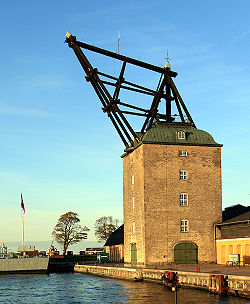
Back بوابة:الدنمارك Arabic Portál:Dánsko Czech Portal:Danmark Danish Portal:Dänemark German Portal:Danimarka DIQ Portal:Dinamarca Spanish Portail:Danemark French Portal:Dinamarca Galician Պորտալ:Դանիա Armenian Portale:Danimarca Italian
Welcome to the Denmark Portal! | ||||

|

|

| |
Denmark is the smallest and southernmost of the Nordic countries. Unified in the 10th century, it is also the oldest. Located north of its only land neighbour, Germany, south-west of Sweden, and south of Norway, it is located in northern Europe. From a cultural point of view, Denmark belongs to the family of Scandinavian countries although it is not located on the Scandinavian Peninsula. The national capital is Copenhagen.
Denmark borders both the Baltic and the North Sea. The country consists of a large peninsula, Jutland, which borders Schleswig-Holstein; many islands, most notably Zealand, Funen, Vendsyssel-Thy, Lolland, and Bornholm; and hundreds of minor islands often referred to as the Danish Archipelago. Denmark has historically controlled the approach to the Baltic Sea, and those waters are also known as the Danish straits.
Denmark has been a constitutional monarchy since 1849 and is a parliamentary democracy. It became a member of the European Economic Community (now the European Union) in 1973. The Kingdom of Denmark also encompasses two off-shore territories, Greenland and the Faroe Islands, both of which enjoy wide-ranging home rule. The Danish monarchy is the oldest existing monarchy in Europe, and the national flag is the oldest state flag in continuous use.
Selected biography

Karen von Blixen-Finecke (April 17, 1885 – September 7, 1962), née Dinesen, was a Danish author also known under her pen name Isak Dinesen. Blixen wrote works both in Danish and in English. She is best known, at least in English, for her account of living in Kenya, Out of Africa, and a film based on one of her stories, Babette's Feast.
Daughter of Ingeborg Westenholz Dinesen, and the writer and army officer Wilhelm Dinesen, and sister of Thomas Dinesen, she was born into a Unitarian aristocratic family in Rungsted on the island of Zealand, in Denmark, and was schooled in art in Copenhagen, Paris, and Rome. She began publishing fiction in various Danish periodicals in 1905 under the pseudonym Osceola, the name of the Seminole Indian leader, and possibly inspired by her father's connection with American Indians. From August 1872 to December 1873, Wilhelm Dinesen had lived among the Chippewa Indians, in Wisconsin, where he fathered a daughter, who was born after his return to Denmark.
Recently selected: Bertel Thorvaldsen - Rasmus Rask - Piet Hein
Selected picture

Selected article
Either/Or portrays two life views, one consciously hedonistic, the other based on ethical duty and responsibility. Each life view is written and represented by a fictional pseudonymous author, the prose of the work depending on the life view being discussed. For example, the aesthetic life view is written in short essay form, with poetic imagery and allusions, discussing aesthetic topics such as music, seduction, drama, and beauty. The ethical life view is written as two long letters, with a more argumentative and restrained prose, discussing moral responsibility, critical reflection, and marriage. The views of the book are not neatly summarized, but are expressed as lived experiences embodied by the pseudonymous authors. The book's central concern is the primal question asked by Aristotle, "How should we live?"
Kierkegaard left Copenhagen in October 1841 to spend the winter in Berlin. Although the main purpose of this visit was to attend lectures by German philosopher Friedrich Wilhelm Joseph Schelling, the lectures turned out to be a disappointment for Kierkegaard and many others. During his stay, Kierkegaard worked on the manuscript for Either/Or and returned to Copenhagen in 1842 with draft of the manuscript, which was completed near the end of 1842 and published in February 1843.
Selected place
With a population of 89,071 (1 January 2010), the Kolding municipality is the seventh largest in Denmark. The city itself has a population of 57,197 (1 January 2011) and is also the seventh largest city in Denmark.
Kolding is well known as the location of the former royal castle of Koldinghus which was built in the 13th century. The castle is now a museum and tourist attraction.
Categories
Denmark topics
Things you can do
- Expand stubs:
Geography stubs · People stubs · Denmark stubs in general
Help us extend these stubs and make them real articles!
- Categorize:
Help us categorize Denmark-related articles
- WikiProjects:
Have a look at WikiProject Denmark, WikiProject Faroe Islands, WikiProject Greenland and WikiProject Norse history and culture
- Noticeboard:
Have a look at the Danish Wikipedians' notice board
- Geotag:
Find coordinates for these locations and tag them: articles missing geocoordinate data
Related portals
Northern Europe
Other countries
Associated WikiMedia
The following Wikimedia Foundation sister projects provide more on this subject:
-
Commons
Free media repository -
Wikibooks
Free textbooks and manuals -
Wikidata
Free knowledge base -
Wikinews
Free-content news -
Wikiquote
Collection of quotations -
Wikisource
Free-content library -
Wikispecies
Directory of species -
Wikiversity
Free learning tools -
Wikivoyage
Free travel guide -
Wiktionary
Dictionary and thesaurus
© MMXXIII Rich X Search. We shall prevail. All rights reserved. Rich X Search












